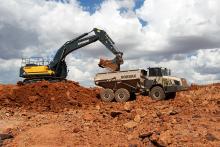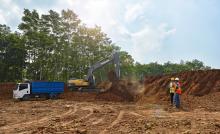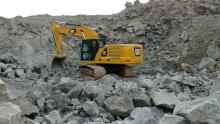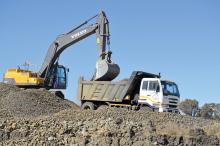
Despite already boasting a large road network spanning more than 213,649km of paved highways and some 154,711km of unpaved highways, Indonesia is demonstrating a voracious appetite for closing what is still a gap in its transport infrastructure. Guy Woodford reports.
From next year, Indonesia’s 250 million plus population along with visitors to the archipelago’s thousands of islands will see an awful lot of construction equipment appear at infrastructure development sites.
To well and truly close Indonesia’s infrastructure gap and, as a result, to ensure the continuation of the nation’s rapid growth, the Master Plan for Acceleration and Expansion of Indonesia’s Economic Development (known as MP3EI) will see the Indonesian Ministry of National Development Planning invest US$536.1 billion in infrastructure projects from 2015-2019. Of this staggering sum, US$104 billion (19%) will be invested in roads.
Such huge financial numbers, and the need for high quality raw materials to make the grand infrastructure vision a reality, makes Indonesia a hot market for aggregates sector firms, not only now but for a number of years to come.
Before the start of its enormous new round of spending on infrastructure, Indonesia will host the 1st IRF Asia Regional Congress and Exhibition in Bali from 17-19 November, 2014. The showpiece event will see transport decision-makers and industry executives from across the region give insights into proven and innovative solutions, latest industry technologies and best practices suited to the region’s growing mobility needs.
Among the globally renowned quarry and road construction-based OEMs looking to maximise commercial opportunities offered by the Indonesian government’s multi-billion dollar investment in new infrastructure are Swedish giants Volvo Construction Equipment.
“Our customers in the quarrying and aggregates sector are currently doing very well and business is growing in line with increasing demand for cement,” says Edy Santara, key account manager,
Santara believes several foreign companies such as China Anhui, China
As an example of the strong equipment sales in Indonesia, Indocement, a
World Bank figures show that in 2013, Indonesia’s GDP reached US$ 868.3 billion - a 5.8% growth over 12 months. Growth in 2014 is projected between 5.1% - 5.5%. Within this, the Construction/ Infrastructure sector has historically enjoyed a 15% yearly growth but is predicted to slow to a still highly impressive 12% due to weakening of the Indonesian Rupiah against the US dollar.
According to Timetric, a leading industry market analysis firm, Indonesia’s construction industry has performed well in recent years, driven by strong economic activity and high levels of investment. Fixed investment has soared over the past decade, with its share of total GDP rising from 19.5% in 2003 to a high of 33.2% in 2012. The construction industry has been a clear beneficiary of this investment, and has grown by 7.4% on an annual average basis, in real terms, over the past 10 years, well above the GDP growth rate of 5.9%. It maintained this rate of growth in 2012, expanding by 7.5%. In line with this trend, says Timetric, the construction sector’s share of total GDP increased from 6.2% in 2003 to 10.4% in 2012. Despite some challenges, Timetric believes the outlook for construction is favourable, supported by urbanisation, rising incomes and government efforts to improve the infrastructure base as a part of the MP3EI.
The Indonesia Cement Association (Asosiasi
Indonesian cement maker Semen Indonesia is aiming to spend US$500 million on capital investment in 2015. The company expects the country’s cement demand to rise due to government continuation of infrastructure projects. Also, the state-run firm predicts that its cement output will reach 40million tonnes/year by 2017.
According to Dwi Soetjipto, the managing director of Semen Indonesia, the company is planning to team up with national property developer Wijaya Karya to develop office and residential buildings on its ex-cement plant site.
The Indonesian cement producer is said to be planning to set up a 50:50 new joint venture unit for this purpose.
It is reported that involvement in the infrastructure sector, such as toll road and the power plant business, are being explored.
Meanwhile, the Mineral and Coal (M&C) 2012 Book produced by Indonesia’s Ministry of Energy and Mineral Resources reports that Indonesian construction materials are largely natural sands and gravel, materials that need minimal reduction and sizing. The aggregates market volume is estimated in the M&C 2012 Book to be 500million tonnes/year - around twice the size of the Australian market. The same source tips market growth to be at 8% a year to 2020.
Shane Menere, president director/general manager (Service, Mining & Construction) for PT
“Metso’s installed base penetrates cement and quarry plants throughout Indonesia and includes crushers and screens for both fixed plant and mobile units. It has an Indonesian office based in Surabaya with full workshop, service and repair capabilities to support customers,” says Menere.
“With an installed capacity of 68 million tonnes of cement in 2013, Indonesia is among the top 10 cement and aggregates producing and consuming countries in the world,” says Rahul Srivastava, a quarry and aggregates specialist at Caterpillar. “The demand for cement and aggregates will continue to grow. Several domestic as well as global cement and aggregates producers have lined up investment plans in Indonesia and it is anticipated that cement installed capacity will exceed 100 million tonnes by 2017.”
Kwan Kin Hoi, vice president,
“Crushing equipment that does exist comes mainly from China, but quarry owners are replacing these with branded units. Sandvik thus sees a great deal of potential growth in the replacement market for these Chinese crushers. However, it remains a price sensitive market.”
After the general elections, Hoi feels the trend of strengthening the Indonesian Rupiah should see increased levels of foreign investment which should provide a spur to growth. Future growth in the Indonesia economy will mean that current levels of plant will, according to Hoi, not be able to cope with demand.
“Quarry owners, and bigger quarry operators, are spoilt for choice and tend to opt for cheaper alternatives rather than premium products. There will be more new players investing in quarries because of the global downturn in the mining industry, with mining companies beginning to shift their focus to quarries. Indonesia has traditionally been a mining market with large volume of sales for mining equipment which should become more prevalent in quarrying and construction.
“The surface drill [sales] opportunities are of similar nature to quarries but again the price sensitivity and competition is extremely fierce.”
Of major infrastructure projects Sandvik hopes to supply equipment for, Hoi adds: “Jakarta is going through a transformation of infrastructure improvement; the country is desperately trying to reduce the traffic congestion by way of the creation of an urban rail system. Thus, the needs for concrete and new roads have direct application for all Sandvik products thereby delivering enormous market potential.”










